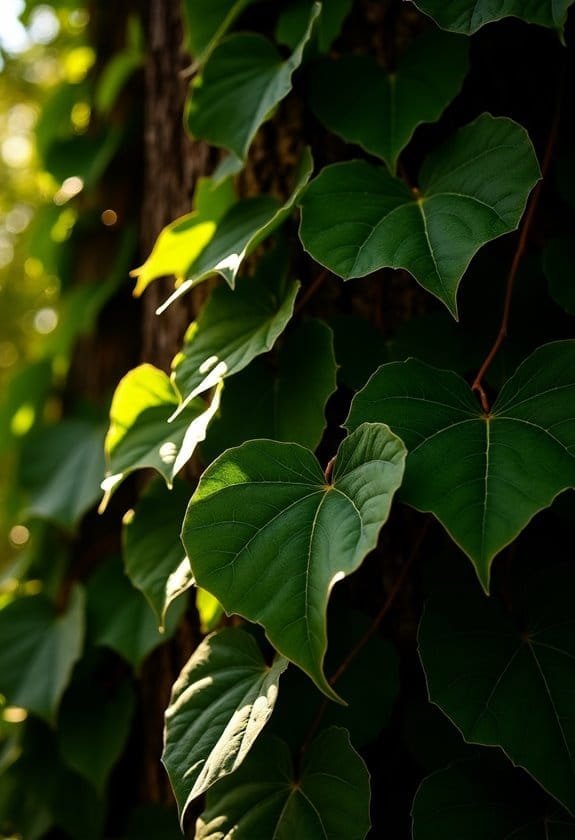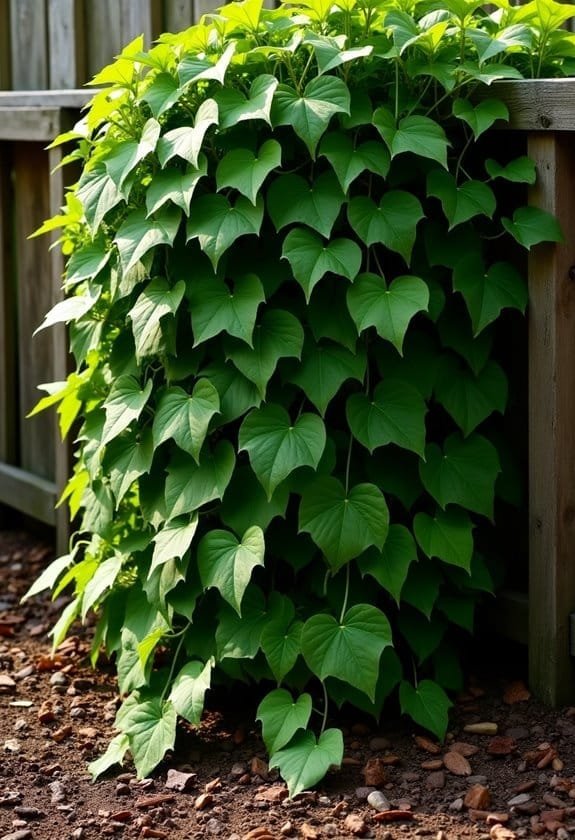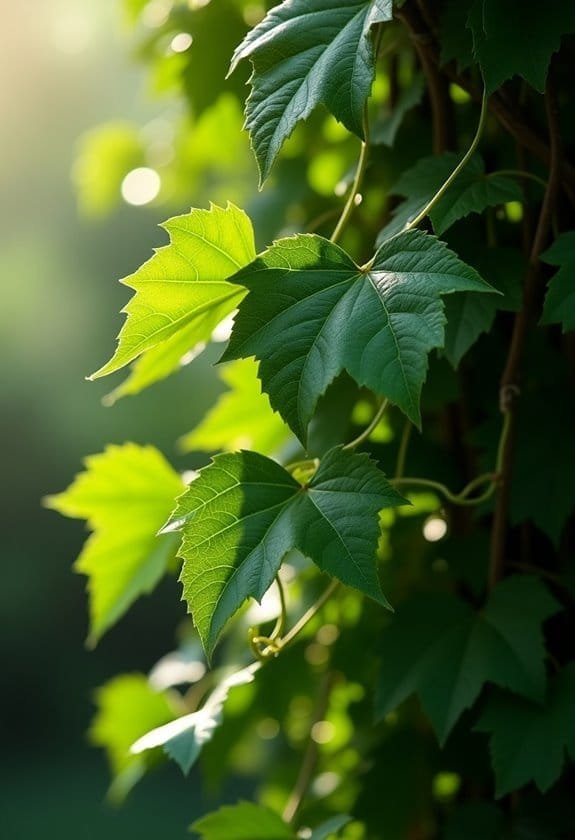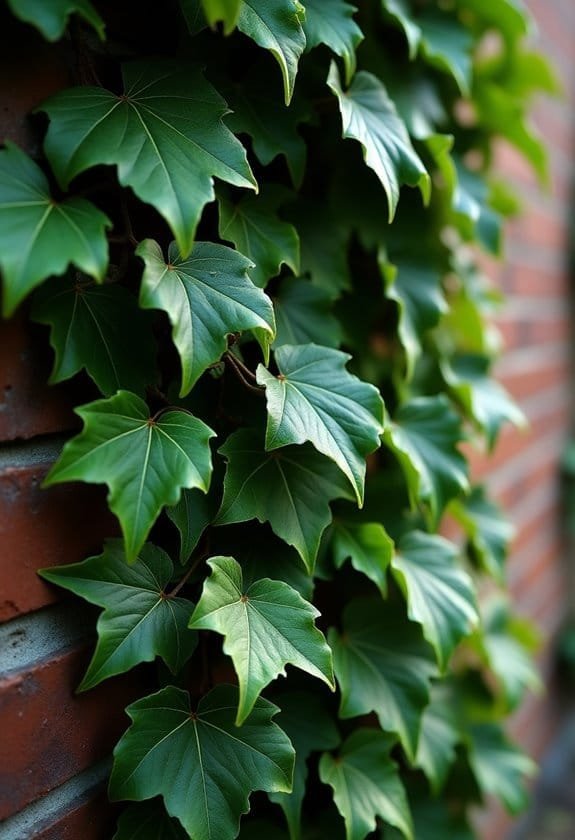Tree Ivy (× Fatshedera Lizei) is a remarkable hybrid, merging characteristics of Fatsia japonica Moserii and Hedera helix. This evergreen perennial typically grows between 3 to 5 feet, exhibiting large, five-lobed leaves that can span up to 8 inches wide. Known for its striking dark green foliage and aromatic stems, it thrives in semi-upright formations, adaptable to containers or ground cover. Tree Ivy flourishes in medium light and well-draining soil while requiring minimal maintenance. Although it faces pests like scales, regular inspections promote healthy growth. For those curious about its versatile uses and care, further exploration reveals even more treasures.
Main Points
- Tree Ivy, or × Fatshedera lizei, is a hybrid between Fatsia japonica Moserii and Hedera helix, characterized by its striking, dark green foliage.
- This evergreen plant typically grows 3 to 5 feet tall and is adaptable for both indoor and outdoor settings.
- It thrives in medium light and prefers well-draining, slightly acidic to neutral soil, with proper watering practices to maintain health.
- Tree Ivy can be easily propagated through softwood or semi-hardwood cuttings, making it accessible for gardeners.
- It serves as a decorative option in landscapes and gardens, harmonizing well with companion plants like Ficus and snake plants.
Introduction

Commonly known as Tree Ivy, the plant × Fatshedera lizei is a fascinating hybrid, resulting from the crossing of Fatsia japonica Moserii and Hedera helix.
This evergreen species, reaching heights of 3 to 5 feet and boasting large, five-lobed leaves up to 8 inches wide, thrives in diverse environments, making it a suitable choice for both indoor and outdoor settings.
Its adaptability and low-maintenance nature allow it to flourish with minimal care, while its ability to tolerate air pollution and coastal conditions enhances its appeal for various landscaping projects.
Common Name
Tree Ivy, known in the gardening world as Bush Ivy or Fatshedera, stands out for its striking appearance and adaptability. This remarkable hybrid, created by crossing Fatsia japonica Moserii with Hedera helix, showcases a unique vine-like growth habit that permits it to reach impressive heights of 3 to 5 feet.
The allure of Tree Ivy lies not only in its stature but also in its large, dark green, five-lobed leaves, which can grow up to 8 inches wide, providing a lush visual counterpart in diverse landscapes.
What enhances Tree Ivy's appeal further is its remarkable tolerance to urban challenges, including air pollution and coastal sea spray. Consequently, this plant thrives in both city settings and seaside environments, making it a valuable addition to any garden.
Primarily evergreen, Tree Ivy produces sterile greenish-white flowers in the fall, enriching its aesthetic without the complications of seed production.
These characteristics guarantee that Tree Ivy not only beautifies spaces but also resists common environmental stressors, reflecting its resilience and versatility in the horticultural world.
Scientific Name
One of the most intriguing aspects of Tree Ivy is its scientific classification, known as × Fatshedera lizei. This name reflects the plant's hybrid nature, resulting from the crossbreeding of two distinct genera: Fatsia japonica and Hedera helix. The "×" preceding its name indicates that Fatshedera lizei is truly a unique creation—a melding of characteristics that results in a striking houseplant.
Belonging to the Araliaceae family, Tree Ivy shares this familial grouping with a range of other woody plants, enriching its botanical lineage. Fatshedera lizei was first discovered in France, where it quickly gained recognition, particularly for its distinctive large, lobed leaves. These leaves can reach widths of up to 8 inches, offering an impressive display that captivates plant enthusiasts.
Classified under the order Apiales, Tree Ivy occupies an important niche in the plant kingdom, showcasing the beauty and complexity inherent in hybridization. This classification not only delineates its scientific identity but also reflects the vibrant diversity of life forms that contribute to our ecosystems.
Through understanding Fatshedera lizei, we can appreciate the intricacies of nature's evolutionary process.
Overview
Renowned for its unique attributes, Tree Ivy (× Fatshedera lizei) stands out as an appealing choice for plant lovers. This hybrid plant, a marriage between Fatsia japonica Moserii and Hedera helix, belongs to the versatile Araliaceae family. Typically growing to a height of 3 to 5 feet, Tree Ivy showcases large, dark green, five-lobed leaves that can reach up to 8 inches in width, creating a striking visual presence in any space.
Its adaptability is significant: Tree Ivy thrives not only as an indoor houseplant but also flourishes outdoors, where it can be trained as a vine or used as groundcover. In addition, this species exhibits a remarkable tolerance to air pollution and coastal sea spray, rendering it suitable for urban environments as well as seaside gardens.
For ideal growth, Tree Ivy prefers moderate light conditions, ensuring its lush foliage remains vibrant and healthy. While it produces sterile greenish-white flowers in the fall, the plant is primarily celebrated for its foliage and resilience. Consequently, Tree Ivy becomes a favored choice for those seeking both beauty and practicality in their horticultural pursuits.
Key Features
Tree Ivy, or × Fatshedera lizei, showcases remarkable characteristics that appeal to both casual gardeners and landscape designers alike.
With its impressive growth potential of 3 to 5 feet in height and large, five-lobed leaves measuring up to 8 inches wide, it creates a lush, green tapestry in any setting.
While this hybrid produces sterile greenish-white flowers in fall, its enchanting foliage is the primary attraction, symbolizing versatility and elegance in urban and coastal environments.
Growth Size
Reaching heights of 3 to 5 feet, Tree Ivy (× Fatshedera lizei) thrives in various landscape settings due to its versatility. Its growth size allows it to effectively fill spaces in a garden or as part of a container arrangement, making it a popular choice among landscape enthusiasts. The plant typically exhibits a spread similar to its height, providing an expansive, lush presence.
As a hybrid of Fatsia japonica and Hedera helix, Tree Ivy showcases a semi-upright growth habit. This characteristic enables it to be trained either as a vine climbing up structures or as groundcover sprawling across the ground, introducing a dynamic element to floral compositions.
However, potential growers should note that this plant's growth rate is fairly slow. Establishing itself in the garden or indoors requires patience, as it takes time for Tree Ivy to develop its full potential.
Moreover, its adaptability allows Tree Ivy to flourish in diverse conditions, thriving in shaded areas beneath taller shrubs or within well-draining containers. This flexibility enhances its appeal, proving it to be a remarkable option for various horticultural applications.
Appearance
Fatshedera lizei enchants with its striking appearance, marked by large, dark green, five-lobed leaves that can reach up to 8 inches in width. These lush leaves create an impressive visual presence, often drawing immediate attention to the tree-like structure of the plant.
Generally, Fatshedera exhibits a semi-upright growth habit, typically attaining heights between 3 to 5 feet, as well as a similar width, which makes it suitable for both indoor and outdoor settings.
The tree's allure is further enhanced by the aromatic stems, adding an engaging sensory experience while complementing the foliage. Variegated cultivars of this unique plant introduce creamy white borders around the vibrant green leaves, providing an extra layer of visual interest that appeals to garden enthusiasts and casual observers alike.
Although Fatshedera lizei produces sterile greenish-white flowers in the fall, these blooms are secondary to the striking foliage, underscoring the plant's ornamental appeal.
This combination of size, color, and aromatic qualities establishes Tree Ivy as a versatile choice for landscape design, capable of enriching both residential and commercial environments with its remarkable and enchanting presence.
Flowering Season
The flowering season of Fatshedera lizei brings a subtle charm to the landscape, as it produces sterile greenish-white flowers in the fall. Typically blooming during the winter months, these blossoms add unique visual interest to Tree Ivy when many other plants lie dormant.
Although the flowers aren't particularly extravagant, their understated elegance offers a gentle contrast against the large, dark green leaves, creating a serene aesthetic.
These sterile flowers eliminate concerns about unwanted seed dispersal, allowing gardeners to appreciate the beauty without worrying about managing new growth. Alongside the floral display, the plant's aromatic stems enhance the sensory experience, inviting a delightful fragrance into garden spaces or interior settings.
With its evergreen nature, Tree Ivy retains its striking foliage year-round, ensuring it remains a vibrant component of any landscape, even when not in bloom.
The flowering season, then, serves not only as a time for aesthetic enjoyment but also as a reminder of the plant's resilience and adaptability. Its blooms may be quietly modest, yet they contribute considerably to the seasonal charm and ecological richness of the environment, knitting an intricate tapestry of textures and scents amid nature's cycles.
Growing Requirements

Tree Ivy, or × Fatshedera lizei, has distinct growing requirements essential for its flourishing.
Preferring medium light, well-draining soil that retains slight moisture, it thrives best in environments where temperatures range from USDA hardiness zones 7b to 10b.
Understanding these needs, along with appropriate watering practices, helps guarantee that this exotic hybrid remains lush and vibrant, avoiding the pitfalls of root rot and inadequate light exposure.
Light
Light plays an essential role in the growth of Tree Ivy, as it thrives best in medium light conditions. Ideally, placing this plant less than three feet from a south-facing window promotes ideal growth. While Tree Ivy can tolerate lower light levels, insufficient sunlight often results in leaf drop and a lanky, unattractive appearance.
This plant requires careful monitoring of its light exposure, adjusting as necessary due to seasonal variations in sunlight availability. It's important to be cautious about direct sunlight; exposure can lead to detrimental leaf bleaching, especially in warmer climates where the intensity of the sun increases.
Conversely, in cooler coastal regions, this adaptable ivy can endure full sun, provided that the soil maintains a slightly damp condition to foster its growth. Regularly evaluating the light situation allows for timely modifications, ensuring the plant receives the adequate light it needs throughout the year.
Soil
Successful growth for Tree Ivy hinges not just on the right light conditions, but also on selecting the appropriate soil. This perennial prefers well-draining soil, ideally a loamy or sandy mix that retains slight moisture without becoming overly saturated. Such conditions greatly reduce the risk of root rot, which can be detrimental to its health.
Tree Ivy thrives best in soil with slightly acidic to neutral pH levels, making commonly available potting mixes quite suitable. To maintain ideal nutrient levels, it's crucial to refresh the soil regularly by repotting once the plant doubles in size. Failures to do so may manifest as slowed growth or yellowing leaves, clear indicators of potential nutrient depletion.
Moreover, monitoring soil moisture is essential for the overall health of Tree Ivy. The soil should dry out between waterings, establishing a balance that prevents the complications associated with both overwatering and underwatering. Additionally, similar to Common Yarrow, its impressive drought resilience allows for adaptation after establishment, reinforcing the importance of proper care.
Striking this balance not only supports robust growth but also fosters a vigorous and lush appearance, illustrating the importance of suitable soil in cultivating a thriving Tree Ivy.
Water
While maintaining the right soil conditions is fundamental, regular watering also plays a key role in helping Tree Ivy flourish. This plant thrives on consistently moist soil, requiring about 0.5 cups of water every nine days when grown in a 5-inch pot, particularly when placed in areas without direct sunlight.
However, it's important to allow the soil to dry out slightly between waterings; overwatering can lead to detrimental effects, such as brown, drooping leaves and root rot, which could jeopardize the plant's health.
During active growth periods, Tree Ivy needs more frequent watering to support its vibrant development. Conversely, as October approaches, one should reduce watering to prevent leaf drop as the plant enters dormancy.
To optimize the watering schedule, utilizing a water calculator can be advantageous, helping determine personalized watering frequencies based on environmental conditions and the size of the plant.
Temperature
For ideal growth, Tree Ivy (× Fatshedera lizei) thrives in a temperature range of 60°F to 75°F (16°C to 24°C), making the plant well-suited for typical indoor environments. This hybrid enjoys mild temperatures, aligning perfectly with the comfort levels of most households.
Positioned within USDA hardiness zones 7b to 10b, it flourishes in temperate climates, although it requires protection from the elements during colder months.
Cold weather poses a significant threat, as frost can severely harm this evergreen species. Sudden drops in temperature can lead to stress, affecting the overall health of the Tree Ivy.
To prevent such issues, gardeners should endeavor to maintain stable conditions and avoid sudden drafts, which can disrupt its delicate equilibrium.
While this hardy plant can adapt to minor temperature fluctuations, it performs best under consistent warmth. Ensuring a favorable temperature not only promotes growth but also enhances the liveliness and aesthetics of Tree Ivy.
Fundamentally, nurturing this plant within its preferred thermal parameters ultimately supports its lush, green foliage and resilience.
Pollinator Criteria
Tree Ivy (× Fatshedera lizei) presents an intriguing case when examining its pollinator criteria, particularly given its sterile flowers that yield neither nectar nor pollen.
While these characteristics limit direct attraction of pollinators, the plant offers a valuable habitat for beneficial insects, creating an ecological niche that aids urban biodiversity.
Additionally, its resilience in polluted environments positions Tree Ivy as a potential sanctuary for those insects that manage to adapt, highlighting the complex interplay between urban flora and local fauna.
Attracted Pollinators
Though the Tree Ivy (× Fatshedera lizei) produces greenish-white flowers in the fall, these blooms are sterile and fail to attract pollinators due to their lack of nectar and pollen. This sterile quality renders the plant ineffective in promoting pollinator health or creating an environment that fosters bee, butterfly, or other beneficial insect activity.
While the flowers provide no nourishment, they may inadvertently draw some curious insects seeking shelter or warmth among the dense foliage. Tree Ivy's lush, thick leaves offer potential habitats, benefiting pollinators indirectly, despite the absence of blooms that generate sustenance.
As a primarily decorative plant, Tree Ivy's sprawling growth habits can create environments that support the movement of pollinators in nearby gardens, enriching local ecosystems.
However, the lack of pollinator-attracting characteristics limits its role in extensive gardening designs focused on fostering insect biodiversity.
Pollination Method
During its fall bloom, the sterile greenish-white flowers of Tree Ivy (× Fatshedera lizei) showcase a unique characteristic of this hybrid plant. This hybrid, created by crossing Fatsia japonica and Hedera helix, is particularly intriguing because it doesn't engage in traditional pollination.
Unlike many flowering plants, Tree Ivy's flowers are sterile, meaning they don't produce viable seeds and consequently don't require a specific pollinator to propagate. Instead, it primarily relies on vegetative reproduction, an efficient process that enables the plant to root from softwood or semi-hardwood cuttings.
While the flowers may catch the attention of some pollinators, such as bees, their presence is merely incidental, lacking any role in the plant's reproductive cycle.
The ability of Tree Ivy to thrive through these alternative propagation methods allows it to maintain robust growth without depending on the typical sexual reproduction processes found in many species. This resilience supports its spread in suitable environments and highlights the remarkable adaptability of this hybrid, further inviting appreciation for its biological uniqueness.
Accordingly, Tree Ivy stands as a fascinating example of how hybrids can evolve distinct survival strategies.
Care & Maintenance

To guarantee the thriving growth of Tree Ivy, ongoing care is essential for its lush development.
This includes consistent watering practices, regular pruning to promote a dense structure, and careful attention to light levels—medium light is important to prevent unsightly leaf drop and stretched growth.
An understanding of its needs will guide plant enthusiasts in creating an ideal environment, enhancing both aesthetics and health.
Planting Tips
When planting Tree Ivy (× Fatshedera Lizei), it's essential to provide the right conditions for ideal growth. This hybrid plant, which boasts Fatsia as one parent, flourishes in medium light but adapts well to lower-light environments. However, inadequate light can induce leaf drop, so placement is key.
To guarantee healthy roots, the soil should remain consistently moist yet not soggy, allowing for slight drying between waterings to avert root rot.
In terms of plant care, regular pruning is beneficial. This practice not only maintains the tree's shape but also encourages a bushier growth habit, preventing the undesirable rangy appearance often associated with neglect.
It's significant that Tree Ivy can even withstand adverse conditions, including air pollution and coastal sea challenges.
While fertilization may seem unnecessary if potting soil is refreshed annually, yellowing leaves might signal a need for nutrients—pay attention to these signs.
Finally, although Tree Ivy is generally disease-resistant, keep an eye out for pests like scales and mealybugs. With minimal intervention, one can enjoy thriving ivy for years, embodying beauty amid environmental challenges.
Ongoing Care
For ongoing care of Tree Ivy (× Fatshedera Lizei), consistent attention to watering, pruning, and light exposure is crucial.
Gardeners should ascertain the soil stays consistently moist, particularly during the growing season; overly dry or soggy conditions can adversely affect the plant's health. Regular pruning maintains the desired shape and prevents a rangy appearance, promoting denser, bushier growth for this popular indoor plant.
Light exposure plays a significant role in the health of Tree Ivy. Ideally, place the plant within three feet of a south-facing window to provide ideal sunlight, as insufficient illumination may lead to leaf drop and weakened growth.
Additionally, while annual soil replenishment typically minimizes the need for fertilizers, signs of nutrient depletion—such as slowed growth or yellowing leaves—may indicate a requirement for nutrient replenishment.
Ongoing care also involves vigilant monitoring for common issues, including yellowing or browning leaves, which often signal problems like overwatering or nutrient deficiency.
Suggested Companions
Creating a vibrant indoor garden with Tree Ivy (× Fatshedera Lizei) becomes even more rewarding by selecting suitable companion plants. This resilient plant thrives alongside Ficus varieties, which contribute their colorful groundcover to enhance the lush, green foliage of Fatshedera lizei.
Furthermore, the incorporation of variegated ivy can dramatically uplift the aesthetic appeal, showcasing intriguing contrasts in leaf patterns and colors.
Another excellent companion is the snake plant, known for its air-purifying properties and adaptability to similar light conditions. When paired with Tree Ivy, they cultivate a healthy indoor environment.
Additionally, Pothos invigorates the space with their trailing vines, lending visual interest and an engaging dynamic to the display.
For those seeking low-maintenance options, ZZ plants shine brightly; they harmonize well due to their matching watering and light requirements.
A particularly striking combination involves introducing Fatsia japonica Moserii, which offers broader leaves and intriguing texture, further complementing the overall arrangement.
Common Issues
Tree Ivy, like many houseplants, can experience various common issues that hinder its flourishing growth.
Pests such as scales and mealybugs may invade, while environmental factors like fluctuating temperatures can exacerbate stress, leading to unwanted leaf drop.
Addressing these problems swiftly guarantees plant health, maintaining a vibrant and robust Tree Ivy.
Pests/Diseases
Maintaining a healthy Tree Ivy (× Fatshedera lizei) requires vigilance against pests and diseases, even though it's generally quite resilient. While this plant often thrives without issues, it can sometimes encounter pests such as scales and mealybugs. These tiny invaders can lead to significant complications, such as stunted growth and leaf drop, if not addressed.
Regular inspection of leaves and stems plays an essential role in catching infestations early; noticing sticky residues, webbing, or the pests themselves can prompt timely intervention. Signs like these indicate the need for immediate action, ideally before damage escalates.
Additionally, ensuring good air circulation around the Tree Ivy and adhering to proper watering practices decreases the likelihood of pest issues, creating an unfavorable environment for these unwanted guests.
Proper pruning of affected areas also serves as a strategy to manage pest populations effectively. This practice not only helps in controlling nuisances but also fosters healthier growth in the Tree Ivy.
Consequently, diligence in monitoring for pests equips gardeners to maintain the beauty and health of their beloved Tree Ivy, allowing it to flourish in its intended environment.
Solutions
To guarantee a vibrant and healthy Tree Ivy, addressing common issues promptly is vital. Yellowing leaves often signal overwatering or nutrient deficiencies, indicating that a thorough inspection of soil moisture levels is essential.
Tree Ivies are tolerant of adverse conditions, yet they flourish best with proper care. If leaves exhibit browning or drooping, this commonly suggests excess moisture, highlighting the need to evaluate drainage and adjust watering practices accordingly.
Insufficient natural light can also lead to troublesome leaf drop. Ideally, the Tree Ivy should be positioned within three feet of a south-facing window, ensuring ample exposure to beneficial sunlight.
Additionally, environmental factors such as temperature and humidity directly affect its well-being; therefore, regular monitoring is necessary to maintain a stable climate.
Lastly, employing regular pruning not only helps maintain an attractive shape, but it also prevents the plant from developing a scraggly appearance.
Summary

The Tree Ivy, or × Fatshedera lizei, is a hybrid plant that beautifully combines traits from its parent species, Fatsia japonica Moserii and Hedera helix.
This evergreen marvel typically reaches heights of 3 to 5 feet, showcasing large, dark green, five-lobed leaves that can grow up to 8 inches wide. The Tree Ivy stands out for its extraordinary adaptability, thriving in shaded environments and resiliently enduring air pollution and coastal sea spray.
While it produces sterile greenish-white flowers in the fall, its primary allure lies in its striking foliage, making it a quintessential ornamental plant.
Easily maintained, the Fatshedera lizei requires minimal care, appealing to both novice and experienced gardeners alike. Its propagation through softwood or semi-hardwood cuttings allows enthusiasts to grow new plants effortlessly.


